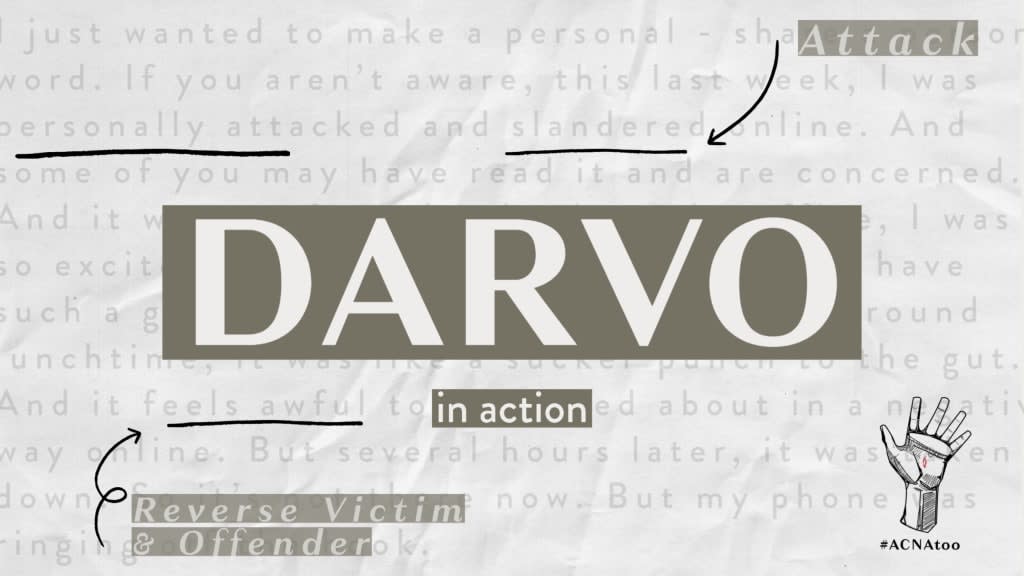Understanding D.A.R.V.O
Unmasking Narcissistic Behavior and Seeking Help

Raise your hand if you have ever been a victim to mental and emotional abuse? Toxic behavior? Psychological harm? Have you ever been hurt by a narcissist over and over because for the longest time, you believed it was you and not them?

... Well, I can't see your hand and you can't see mine, but if you are raising yours let me help you break down that feeling. When you suddenly get scared that you are in the wrong? Maybe, they're right. You are imagining it or you created that problem that it feels like they made up. But it was somehow definitely you.
What you are most likely experiencing or have experienced is a step, before gaslighting that is not often talked about. It's called DARVO.
Before I explain that, let me start with:: Abuser 101; They will make their victim feel numb to abusive traits in order to get away with it. They make it normal.
So, with that in mind, DARVO is essentially a preemptive gaslight technique that makes victims believe they are the real abusers and not the other way around.
D. (Deny) A. (Attack) R. (Reverse) V. (Victim) O. (Offender) In today's society, the prevalence of narcissistic behavior is a growing concern. One disturbing tactic employed by narcissists is D.A.R.V.O: Deny, Attack, Reverse, Victim, Offender. This article aims to shed light on this manipulative behavior pattern, its detrimental effects on individuals, and the importance of seeking help to break free from its grip.
I. Deny:
The first component of D.A.R.V.O is denial. Narcissists frequently deny their actions, emotions, or any responsibility for their wrongdoings. By employing this tactic, they attempt to deflect accountability and maintain a false self-image. Denial allows them to manipulate and gaslight their victims, leaving them confused and doubting their own experiences.
II. Attack:
The second component of D.A.R.V.O is attack. Narcissists often resort to aggressive tactics to divert attention away from their own actions. They may subject their victims to verbal, emotional, or even physical abuse. By attacking their victims, narcissists aim to silence them, instill fear, and regain control over the narrative.
III. Reverse:
The third component of D.A.R.V.O is reversal. Narcissists skillfully reverse the roles, projecting their own guilt, flaws, or insecurities onto their victims. By doing so, they manipulate others into believing that they are the ones who have caused harm or deserve blame. This reversal tactic allows narcissists to escape accountability while further victimizing their targets.
IV. Victim:
The fourth component of D.A.R.V.O is playing the victim. Narcissists often portray themselves as the ones who have been wronged, using this tactic to gain sympathy and support from others. By presenting themselves as victims, they manipulate the perception of those around them, reinforcing their false self-image and diverting attention from their own abusive behaviors.
V. Offender:
The final component of D.A.R.V.O is transforming the victim into the offender. Narcissists skillfully manipulate the narrative to make it seem as though their victims are the ones at fault. By doing so, they not only evade accountability but also further harm the psychological well-being of their victims, who may internalize the false accusations and experience self-doubt and guilt.
Now we reach our conclusion;
Recognizing and understanding D.A.R.V.O is crucial in identifying and dealing with narcissistic behavior. The denial, attack, reverse, victim, and offender tactics employed by narcissists can have profound and lasting effects on their victims. Breaking free from this cycle requires seeking help and support from trusted individuals, such as therapists, counselors, or support groups. It is essential to educate ourselves and others about narcissistic behavior, fostering a society that promotes empathy, understanding, and empowerment for victims. By doing so, we can create a safer environment that encourages healing and growth for those who have been impacted by D.A.R.V.O and other forms of narcissistic abuse.
About the Creator
Kaliyah Myers
"Change is imperative. But the kind of change is the most important detail."
In being a writer, I hope to share something relatable and adventurous that you can love too.






Comments (1)
Very informative! I’ve had to deal with narcissists!